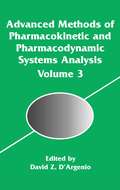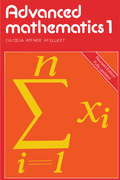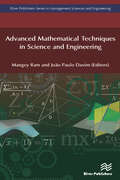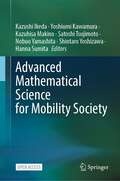- Table View
- List View
Advanced Microeconomics
by Harald WieseThis textbook for master programs in economics offers a comprehensive overview of microeconomics. It employs a carefully graded approach where basic game theory concepts are already explained within the simpler decision framework. The unavoidable mathematical content is supplied when needed, not in an appendix.The book covers a lot of ground, from decision theory to game theory, from bargaining to auction theory, from household theory to oligopoly theory, and from the theory of general equilibrium to regulation theory. Additionally, cooperative game theory is introduced. This textbook has been recommended and developed for university courses in Germany, Austria and Switzerland.
Advanced Methods of Structural Analysis
by Igor A. Karnovsky Olga LebedThis revised and significantly expanded edition contains a rigorous examination of key concepts, new chapters and discussions within existing chapters, and added reference materials in the appendix, while retaining its classroom-tested approach to helping readers navigate through the deep ideas, vast collection of the fundamental methods of structural analysis. The authors show how to undertake the numerous analytical methods used in structural analysis by focusing on the principal concepts, detailed procedures and results, as well as taking into account the advantages and disadvantages of each method and sphere of their effective application. The end result is a guide to mastering the many intricacies of the range of methods of structural analysis. The book differentiates itself by focusing on extended analysis of beams, plane and spatial trusses, frames, arches, cables and combined structures; extensive application of influence lines for analysis of structures; simple and effective procedures for computation of deflections; introduction to plastic analysis, stability, and free and forced vibration analysis, as well as some special topics. Ten years ago, Professor Igor A. Karnovsky and Olga Lebed crafted a must-read book. Now fully updated, expanded, and titled Advanced Methods of Structural Analysis (Strength, Stability, Vibration), the book is ideal for instructors, civil and structural engineers, as well as researches and graduate and post graduate students with an interest in perfecting structural analysis.
Advanced Methods of Solid Oxide Fuel Cell Modeling (Green Energy and Technology)
by Jarosław Milewski Konrad Świrski Massimo Santarelli Pierluigi LeoneFuel cells are widely regarded as the future of the power and transportation industries. Intensive research in this area now requires new methods of fuel cell operation modeling and cell design. Typical mathematical models are based on the physical process description of fuel cells and require a detailed knowledge of the microscopic properties that govern both chemical and electrochemical reactions. Advanced Methods of Solid Oxide Fuel Cell Modeling proposes the alternative methodology of generalized artificial neural networks (ANN) solid oxide fuel cell (SOFC) modeling. Advanced Methods of Solid Oxide Fuel Cell Modeling provides a comprehensive description of modern fuel cell theory and a guide to the mathematical modeling of SOFCs, with particular emphasis on the use of ANNs. Up to now, most of the equations involved in SOFC models have required the addition of numerous factors that are difficult to determine. The artificial neural network (ANN) can be applied to simulate an object’s behavior without an algorithmic solution, merely by utilizing available experimental data. The ANN methodology discussed in Advanced Methods of Solid Oxide Fuel Cell Modeling can be used by both researchers and professionals to optimize SOFC design. Readers will have access to detailed material on universal fuel cell modeling and design process optimization, and will also be able to discover comprehensive information on fuel cells and artificial intelligence theory.
Advanced Methods of Pharmacokinetic and Pharmacodynamic Systems Analysis (The Springer International Series in Engineering and Computer Science #765)
by David D'ArgenioAdvanced Methods of Pharmacokinetic and Pharmocodynamic Systems Analysis Volume 3 is vital to professionals and academicians working in drug development and bioengineering. Both basic and clinical scientists will benefit from this work.This book contains chapters by leading researchers in pharmacokinetic/pharmacodynamic modeling and will be of interest to anyone involved with the application of pharmacokinetic and pharmacodynamics to drug development. The use of mathematical modeling and associated computational methods is central to the study of the absorption, distribution and elimination of therapeutic drugs (pharmacokinetics) and to understanding how drugs produce their effects (pharmacodynamics). From its inception, the field of pharmacokinetics and pharmacodynamics has incorporated methods of mathematical modeling, simulation and computation in an effort to better understand and quantify the processes of uptake, disposition and action of therapeutic drugs. These methods for pharmacokinetic/pharmacodynamic systems analysis impact all aspects of drug development. In vitro, animal and human testing, as well as drug therapy are all influenced by these methods. Modeling methodologies developed for studying pharmacokinetic/ pharmacodynamic processes confront many challenges. This is related in part to the severe restrictions on the number and type of measurements that are available from laboratory experiments and clinical trials, as well as the variability in the experiments and the uncertainty associated with the processes themselves. The contributions are organized in three main areas: Mechanism-Based PK/PD, Pharmacometrics and Pharmacotherapy. Both professionals and academics will profit from this extensive work.
Advanced Methods in the Fractional Calculus of Variations (SpringerBriefs in Applied Sciences and Technology)
by Agnieszka B. Malinowska Tatiana Odzijewicz Delfim F.M. TorresThis brief presents a general unifying perspective on the fractional calculus. It brings together results of several recent approaches in generalizing the least action principle and the Euler–Lagrange equations to include fractional derivatives.The dependence of Lagrangians on generalized fractional operators as well as on classical derivatives is considered along with still more general problems in which integer-order integrals are replaced by fractional integrals. General theorems are obtained for several types of variational problems for which recent results developed in the literature can be obtained as special cases. In particular, the authors offer necessary optimality conditions of Euler–Lagrange type for the fundamental and isoperimetric problems, transversality conditions, and Noether symmetry theorems. The existence of solutions is demonstrated under Tonelli type conditions. The results are used to prove the existence of eigenvalues and corresponding orthogonal eigenfunctions of fractional Sturm–Liouville problems.Advanced Methods in the Fractional Calculus of Variations is a self-contained text which will be useful for graduate students wishing to learn about fractional-order systems. The detailed explanations will interest researchers with backgrounds in applied mathematics, control and optimization as well as in certain areas of physics and engineering.
Advanced Methods for Inconsistent Knowledge Management (Advanced Information and Knowledge Processing)
by Ngoc Thanh NguyenThis book is a first. It fills a major gap in the market and provides a wide snapshot of intelligent technologies for inconsistency resolution. The need for this resolution of knowledge inconsistency arises in many practical applications of computer systems. This kind of inconsistency results from the use of various resources of knowledge in realizing practical tasks. These resources are often autonomous and use different mechanisms for processing knowledge about the same real world. This can lead to compatibility problems.
Advanced Methods for Geometric Modeling and Numerical Simulation (Springer INdAM Series #35)
by Carlotta Giannelli Hendrik SpeleersThis book gathers selected contributions presented at the INdAM Workshop “DREAMS”, held in Rome, Italy on January 22−26, 2018. Addressing cutting-edge research topics and advances in computer aided geometric design and isogeometric analysis, it covers distinguishing curve/surface constructions and spline models, with a special focus on emerging adaptive spline constructions, fundamental spline theory and related algorithms, as well as various aspects of isogeometric methods, e.g. efficient quadrature rules and spectral analysis for isogeometric B-spline discretizations. Applications in finite element and boundary element methods are also discussed. Given its scope, the book will be of interest to both researchers and graduate students working in these areas.
Advanced Methodologies for Bayesian Networks: Second International Workshop, AMBN 2015, Yokohama, Japan, November 16-18, 2015. Proceedings (Lecture Notes in Computer Science #9505)
by Joe Suzuki Maomi UenoThis volume constitutes the refereed proceedings of the Second International Workshop on Advanced Methodologies for Bayesian Networks, AMBN 2015, held in Yokohama, Japan, in November 2015. The 18 revised full papers and 6 invited abstracts presented were carefully reviewed and selected from numerous submissions. In the International Workshop on Advanced Methodologies for Bayesian Networks (AMBN), the researchers explore methodologies for enhancing the effectiveness of graphical models including modeling, reasoning, model selection, logic-probability relations, and causality. The exploration of methodologies is complemented discussions of practical considerations for applying graphical models in real world settings, covering concerns like scalability, incremental learning, parallelization, and so on.
Advanced Mechanics of Piezoelectricity
by Qinghua Qin"Advanced Mechanics of Piezoelectricity" presents a comprehensive treatment of piezoelectric materials using linear electroelastic theory, symplectic models, and Hamiltonian systems. It summarizes the current state of practice and presents the most recent research findings in piezoelectricity. It is intended for researchers and graduate students in the fields of applied mechanics, material science and engineering, computational engineering, and aerospace engineering. Dr. Qinghua Qin is a professor at the School of Engineering, Australian National University, Australia.
Advanced Maths For Aqa - Mechanics (PDF)
by Brian Jefferson Brian Gaulter Craig SimmsMechanics M1 is part of a brand new series of books that match the AQA specifications for Maths A-level, to be first taught from September 2004. The book has been produced in consultation with a Senior Examiner to ensure complete and authoritative coverage of the Mechanics 1 module. Itcontains all the mechanics that students need to know for AS-level Mathematics, or for the first year of an A-level.
Advanced Maths For AQA: A Level Maths For AQA Module C3/4 (PDF)
by Robert Smedley Garry Wiseman Jeff SearleProduced in collaboration with a senior examiner to ensure complete and authoritative coverage of the Pure Core 3 and Pure Core 4 modules, this textbook contains all the pure maths that students need to know for the second half of an A-level.
Advanced Mathematics for Engineers and Physicists
by Sever Angel Popescu Marilena JianuThis book is designed to be an introductory course to some basic chapters of Advanced Mathematics for Engineering and Physics students, researchers in different branches of Applied Mathematics and anyone wanting to improve their mathematical knowledge by a clear, live, self-contained and motivated text.Here, one can find different topics, such as differential (first order or higher order) equations, systems of differential equations, Fourier series, Fourier and Laplace transforms, partial differential equations, some basic facts and applications of the calculus of variations and, last but not least, an original and more intuitive introduction to probability theory. All these topics are carefully introduced, with complete proofs, motivations, examples, applications, problems and exercises, which are completely solved at the end of the book.We added a generous supplementary material (11.1) with a self-contained and complete introduction to normed, metric and Hilbert spaces. Since we used some topics from complex function theory, we also introduced in Chapter 11 a section (11.2) with the basic facts in this important field.What a reader needs for a complete understanding of this book? For a deep understanding of this book, it is required to take a course in undergraduate calculus and linear algebra. We mostly tried to use the engineering intuition instead of insisting on mathematical tricks. The main feature of the material presented here is its clarity, motivation and the genuine desire of the authors to make extremely transparent the "mysterious" mathematical tools that are used to describe and organize the great variety of impressions that come to the searching mind, from the infinite complexity of Nature.The book is recommended not only to engineering and physics students or researchers but also to junior students in mathematics because it shows the connection between pure mathematics and physical phenomena, which always supply motivations for mathematical discoveries.
Advanced Mathematics: A Transitional Reference
by Stanley J. FarlowProvides a smooth and pleasant transition from first-year calculus to upper-level mathematics courses in real analysis, abstract algebra and number theory Most universities require students majoring in mathematics to take a “transition to higher math” course that introduces mathematical proofs and more rigorous thinking. Such courses help students be prepared for higher-level mathematics course from their onset. Advanced Mathematics: A Transitional Reference provides a “crash course” in beginning pure mathematics, offering instruction on a blendof inductive and deductive reasoning. By avoiding outdated methods and countless pages of theorems and proofs, this innovative textbook prompts students to think about the ideas presented in an enjoyable, constructive setting. Clear and concise chapters cover all the essential topics students need to transition from the "rote-orientated" courses of calculus to the more rigorous "proof-orientated” advanced mathematics courses. Topics include sentential and predicate calculus, mathematical induction, sets and counting, complex numbers, point-set topology, and symmetries, abstract groups, rings, and fields. Each section contains numerous problems for students of various interests and abilities. Ideally suited for a one-semester course, this book: Introduces students to mathematical proofs and rigorous thinking Provides thoroughly class-tested material from the authors own course in transitioning to higher math Strengthens the mathematical thought process of the reader Includes informative sidebars, historical notes, and plentiful graphics Offers a companion website to access a supplemental solutions manual for instructors Advanced Mathematics: A Transitional Reference is a valuable guide for undergraduate students who have taken courses in calculus, differential equations, or linear algebra, but may not be prepared for the more advanced courses of real analysis, abstract algebra, and number theory that await them. This text is also useful for scientists, engineers, and others seeking to refresh their skills in advanced math.
Advanced Mathematics: A Transitional Reference (Dover Books On Advanced Mathematics)
by Stanley J. FarlowProvides a smooth and pleasant transition from first-year calculus to upper-level mathematics courses in real analysis, abstract algebra and number theory Most universities require students majoring in mathematics to take a “transition to higher math” course that introduces mathematical proofs and more rigorous thinking. Such courses help students be prepared for higher-level mathematics course from their onset. Advanced Mathematics: A Transitional Reference provides a “crash course” in beginning pure mathematics, offering instruction on a blendof inductive and deductive reasoning. By avoiding outdated methods and countless pages of theorems and proofs, this innovative textbook prompts students to think about the ideas presented in an enjoyable, constructive setting. Clear and concise chapters cover all the essential topics students need to transition from the "rote-orientated" courses of calculus to the more rigorous "proof-orientated” advanced mathematics courses. Topics include sentential and predicate calculus, mathematical induction, sets and counting, complex numbers, point-set topology, and symmetries, abstract groups, rings, and fields. Each section contains numerous problems for students of various interests and abilities. Ideally suited for a one-semester course, this book: Introduces students to mathematical proofs and rigorous thinking Provides thoroughly class-tested material from the authors own course in transitioning to higher math Strengthens the mathematical thought process of the reader Includes informative sidebars, historical notes, and plentiful graphics Offers a companion website to access a supplemental solutions manual for instructors Advanced Mathematics: A Transitional Reference is a valuable guide for undergraduate students who have taken courses in calculus, differential equations, or linear algebra, but may not be prepared for the more advanced courses of real analysis, abstract algebra, and number theory that await them. This text is also useful for scientists, engineers, and others seeking to refresh their skills in advanced math.
Advanced Mathematical Thinking: A Special Issue of Mathematical Thinking and Learning
by Annie Selden John SeldenFirst Published in 2005. Routledge is an imprint of Taylor & Francis, an informa company.
Advanced Mathematical Thinking: A Special Issue of Mathematical Thinking and Learning
by Annie Selden John SeldenFirst Published in 2005. Routledge is an imprint of Taylor & Francis, an informa company.
Advanced Mathematical Thinking (Mathematics Education Library #11)
by David TallThis book is the first major study of advanced mathematical thinking as performed by mathematicians and taught to students in senior high school and university. Topics covered include the psychology of advanced mathematical thinking, the processes involved, mathematical creativity, proof, the role of definitions, symbols, and reflective abstraction. It is highly appropriate for the college professor in mathematics or the general mathematics educator.
Advanced Mathematical Techniques in Science and Engineering
by Mangey Ram; Joãao Paulo DavimIn recent years, mathematical techniques applied to novel disciplines within the science and engineering have experienced extraordinary growth. Advanced Mathematical Techniques in Science and Engineering focusses on a detailed range of mathematics applied within various fields of science and engineering for different tasks. Topics of focus include:- Analysis of Consensus-Building Time in Social Groups- Modeling of intersystem accidents in critical infrastructure systems- Stochastic approaches to analysis and modeling of multi-sources and big data- Performance evaluation of computational DoS attack on access point in Wireless LANs- Ranking methods for decision-making under uncertainty- Understanding time delay based Modeling & Diffusion of technological products- Role of soft computing in science and engineering- Complex system reliability analysis and optimization- Tree growth models in forest ecosystems modellingThis research book can be used as a reference for students in a final year undergraduate engineering course, such as mechanical, mechatronics, industrial, computer science, information technology, etc. Furthermore, the book can serve as a valuable reference for academics, engineers and researchers in these and related subject areas.
Advanced Mathematical Techniques in Science and Engineering
In recent years, mathematical techniques applied to novel disciplines within the science and engineering have experienced extraordinary growth. Advanced Mathematical Techniques in Science and Engineering focusses on a detailed range of mathematics applied within various fields of science and engineering for different tasks. Topics of focus include:- Analysis of Consensus-Building Time in Social Groups- Modeling of intersystem accidents in critical infrastructure systems- Stochastic approaches to analysis and modeling of multi-sources and big data- Performance evaluation of computational DoS attack on access point in Wireless LANs- Ranking methods for decision-making under uncertainty- Understanding time delay based Modeling & Diffusion of technological products- Role of soft computing in science and engineering- Complex system reliability analysis and optimization- Tree growth models in forest ecosystems modellingThis research book can be used as a reference for students in a final year undergraduate engineering course, such as mechanical, mechatronics, industrial, computer science, information technology, etc. Furthermore, the book can serve as a valuable reference for academics, engineers and researchers in these and related subject areas.
Advanced Mathematical Techniques in Engineering Sciences (Science, Technology, and Management)
by Mangey Ram J. Paulo DavimThe goal of this book is to publish the latest mathematical techniques, research, and developments in engineering. This book includes a comprehensive range of mathematics applied in engineering areas for different tasks. Various mathematical tools, techniques, strategies, and methods in engineering applications are covered in each chapter. Mathematical techniques are the strength of engineering sciences and form the common foundation of all novel disciplines within the field. Advanced Mathematical Techniques in Engineering Sciences provides an ample range of mathematical tools and techniques applied across various fields of engineering sciences. Using this book, engineers will gain a greater understanding of the practical applications of mathematics in engineering sciences. Features Covers the mathematical techniques applied in engineering sciences Focuses on the latest research in the field of engineering applications Provides insights on an international and transnational scale Offers new studies and research in modeling and simulation
Advanced Mathematical Techniques in Engineering Sciences (Science, Technology, and Management)
by Mangey Ram J. Paulo DavimThe goal of this book is to publish the latest mathematical techniques, research, and developments in engineering. This book includes a comprehensive range of mathematics applied in engineering areas for different tasks. Various mathematical tools, techniques, strategies, and methods in engineering applications are covered in each chapter. Mathematical techniques are the strength of engineering sciences and form the common foundation of all novel disciplines within the field. Advanced Mathematical Techniques in Engineering Sciences provides an ample range of mathematical tools and techniques applied across various fields of engineering sciences. Using this book, engineers will gain a greater understanding of the practical applications of mathematics in engineering sciences. Features Covers the mathematical techniques applied in engineering sciences Focuses on the latest research in the field of engineering applications Provides insights on an international and transnational scale Offers new studies and research in modeling and simulation
Advanced Mathematical Science for Mobility Society
by Kazushi Ikeda Yoshiumi Kawamura Kazuhisa Makino Satoshi Tsujimoto Nobuo Yamashita Shintaro Yoshizawa Hanna SumitaThis open access book presents the mathematical methods for huge data and network analysis.The automotive industry has made steady progress in technological innovations under the names of Connected Autonomous-Shared-Electric (CASE) and Mobility as a Service (MaaS). Needless to say, mathematics and informatics are important to support such innovations. As the concept of cars and movement itself is diversifying, they are indispensable for grasping the essence of the future mobility society and building the foundation for the next generation. Based on this idea, Research unit named "Advanced Mathematical Science for Mobility Society" was established at Kyoto University as a base for envisioning a future mobility society in collaboration with researchers led by Toyota Motor Corporation and Kyoto University.This book contains three main contents.1. Mathematical models of flow2. Mathematical methodsfor huge data and network analysis3. Algorithm for mobility societyThe first one discusses mathematical models of pedestrian and traffic flow, as they are important for preventing accidents and achieving efficient transportation. The authors mainly focus on global dynamics caused by the interaction of particles. The authors discuss many-body particle systems in terms of geometry and box-ball systems. The second one consists of four chapters and deals with mathematical technologies for handling huge data related to mobility from the viewpoints of machine learning, numerical analysis, and statistical physics, which also includes blockchain techniques. Finally, the authors discuss algorithmic issues on mobility society. By making use of car-sharing service as an example of mobility systems, the authors consider how to construct and analyze algorithms for mobility system from viewpoints of control, optimization, and AI.





















